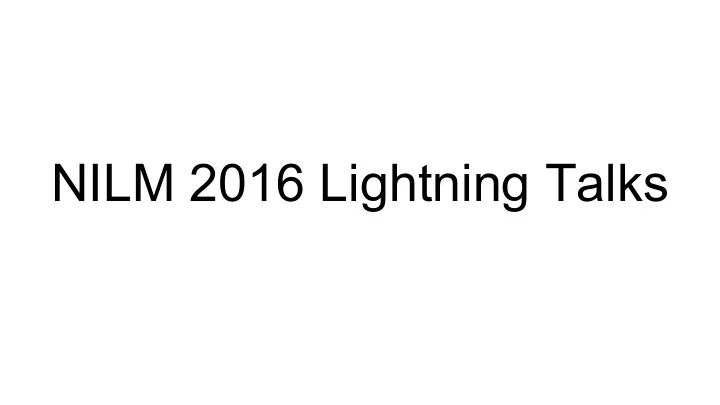

NILM 2016 Lightning Talks
Running order 1. Occupancy-aided Energy Disaggregation 2. Analyzing 100 Billion Measurements: A NILM Architecture for Production Environments 3. An Accurate Method of Energy Use Prediction for Systems with Known Composition 4. Simple Event Detection and Disaggregation Approach for Residential Energy Estimation 5. Towards a Cost-Effective High-Frequency Energy Data Acquisition System for Electric Appliances 6. Unsupervised Learning Algorithm using multiple Electrical Low and High Frequency Features for the task of Load Disaggregation 7. WHITED - A Worldwide Household and Industry Transient Energy Data Set 8. Event Detection in NILM using Cepstrum smoothing 9. A New Measurement System for High Frequency NILM with Controlled Aggregation Scenarios 10. Graphical Closure Rules for Unsupervised Load Classification in NILM Systems 11. An Improved Event Detection Algorithm for Non-Intrusive Load Monitoring System for Low Frequency Smart Meters
Occupancy-aided Energy Disaggregation — to reduce computational complexity occupied occupied occupied Guoming Tang and Kui Wu , University of Victoria, BC, Canada
Analyzing 100 Billion Measurements: A NILM Architecture for Production Environments One interface ... … many NILM approaches
An accurate method of energy use prediction for systems with known composition Jacob A. Mueller and Jonathan W. Kimball, Missouri University of Science and Technology Distinguishing Assumption • System contains no unmodeled devices • Valid for industrial and vehicular power systems, not for residential applications Key Approach • Maximize probability of device-level predictions as a constrained optimization problem • Resulting predictions provide time-accurate profiles of device behavior Applications • Early warning of device damage or malfunction • Noninvasive support for fault detection, identification, and recovery operations Comparison of Comparison of Refrigerator Results LCD TV Results
Simple Event Detection and Disaggregation Approach for Residential Energy Estimation Awet A. Girmay, Christian Camarda •Associate paired events to appliances based on •Signal acquisition using ned-meter, Flex- geometric spike features and usage patterns of loads. plug & data from big utility suppliers in Italy. •An active window based NILM approach for event detection and feature extraction. Devices activities Single device activities •Utilizes an unsupervised localized events clustering and pairs matching Background using automatic clustering methods (DE power level & GA) •Identifies active windows as single or multiple devices operations and learns power states observed. www.midorisrl.eu
Towards a Cost-Effective High-Frequency Energy Thomas Kriechbaumer, Anwar Ul Haq, Data Acquisition System for Electric Appliances Matthias Kahl, and Hans-Arno Jacobsen Features ● Modular design ● Waveform reconstruction ● Fully independent monitored power outlets ● Configurable sampling frequency: up to 30 kHz ● Cost-effective data acquisition: less than 100 € Sensor Board ● Power supply: 5V @ 1W ● Current signals: 6 independent ACS712 ● Voltage signal: 6Vrms AC-AC transformer Sampler Board ● Attached to Raspberry Pi via GPIO and USB ● Independent 12-bit ADCs: MCP3201 ● Microcontroller : ATmega324PA ● USB interface: FTDI232H
Unsupervised Learning Algorithm using multiple Electrical Low and High Frequency Features Electrical Features Unsupervised Learning a. Real and reactive power • Event-based & clustering approach • New project in industrial applications b. Harmonics c. EMI
WHITED A Worldwide Household and Industry Transient Energy Data Set Matthias Kahl, Anwar Ul Haq, Thomas Kriechbaumer, Hans-Arno Jacobsen Motivation Data Set Facts • High resolution data • Sampling with 44.100Hz @ 16-Bit • Simple design • 10 start-ups for each appliance • Low cost components • 1100 different records as flac files • Crowd sourced initiative • 110 different appliances • 47 different appliance types • Data from 7 regions / 3 countries Measurement Equipment For measuring the current, we use a • 3-port extension cord • YHDC current clamp (30A/1V) • AC-AC transformer (230V to 11V) • Voltage divider (11V to 0.47V) • CSL USB sound card (CM6206 Chipset) Data Quality • Spectral nonlinearity < 0.26dB at 3320Hz • Sound card line-in SNR: ~76dB • Current / power step size: 13.5 mA / 3.1 W Toaster Drilling machine Mixer Powertec Pro Work SMJ 500e Kenwood CH580
Event Detection in NILM using Cepstrum smoothing Leen De Baets, Joeri Ruyssinck, Dirk Deschrijver and Tom Dhaene, Ghent University
A New Measurement System for High Frequency NILM with Controlled Aggregation Scenarios Mohamed Nait Meziane, Thomas Picon et al., University of Orléans, France A variable sampling rate The control over turn-on/off Aggregation scenarios up to 1.25 MHz wrt the AC sinusoid (up to 6 loads)
Joseph Krall, Sohei Okamoto, Hampden Kuhns 1) Event Detection: steady states and transitions. Clustering: fixed-Radius, nearest neighbor. 2) Graph: Steady States are vertices. Transitions are edges. 3) Cycle detection: transitions in cycles become closure rules. 4) 1x1 rule/cycles (+x, -x) represent loads. Transitions are defined. 5) Graph traversal from min-power steady state. Steady states are defined. A clip from BLUED
An Improved Event Detection Algorithm for Non-Intrusive Load Monitoring System for Low Frequency Smart Meters Abdullah Al Imran, Minhaz Ahmed Syrus, and Hafiz Abdur Rahman Windowing sampling and steady-state averaging causes edge offset. ▪ Use two threshold edge detection algorithm to detect consistent edge, reduce edge/event offset ▪ Real power edge and reactive power edge matching, edge pruning ▪ Transient impulse/edge detection as a complementary parameter to differentiate event space overlaps Fig.: Edge offset (iAWE data) Fig.: Edge offset Fig.: Five Steps of Transient edge detection Fig.: Transient edge as a differentiating parameter
Recommend
More recommend